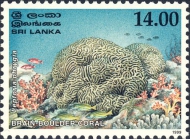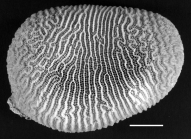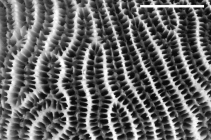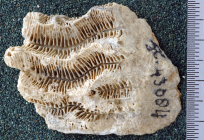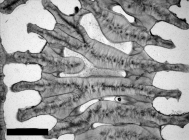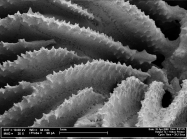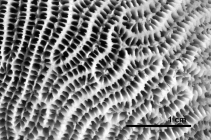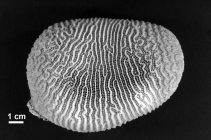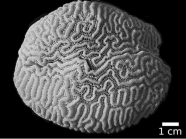WoRMS taxon details
Leptoria Milne Edwards & Haime, 1848
204155 (urn:lsid:marinespecies.org:taxname:204155)
accepted
Genus
Meandrina phrygia (Ellis & Solander, 1786) accepted as Leptoria phrygia (Ellis & Solander, 1786) (type by original designation)
- Species Leptoria irregularis Veron, 1990
- Species Leptoria phrygia (Ellis & Solander, 1786)
- Species Leptoria fragilis Duchassaing & Michelotti, 1860 accepted as Colpophyllia natans (Houttuyn, 1772) (unaccepted > junior subjective synonym)
- Species Leptoria gracilis (Dana, 1846) accepted as Leptoria phrygia (Ellis & Solander, 1786) (unaccepted > junior subjective synonym)
- Species Leptoria hieroglyphica Duchassaing & Michelotti, 1860 accepted as Pseudodiploria clivosa (Ellis & Solander, 1786) (unaccepted > junior subjective synonym)
- Species Leptoria ryukyuensis (Yabe & Sugiyama, 1935) accepted as Platygyra ryukyuensis Yabe & Sugiyama, 1935 (unaccepted > superseded combination)
- Species Leptoria tenuis (Dana, 1846) accepted as Leptoria phrygia (Ellis & Solander, 1786) (unaccepted > junior subjective synonym)
- Species Leptoria pachyphylla Milne Edwards & Haime, 1849 (uncertain > taxon inquirendum)
marine, fresh, terrestrial
recent + fossil
Milne Edwards, H.; Haime, J. (1848). Note sur la classification de la deuxième tribu de la famille des Astréides. <em>Comptes rendus hebdomadaires des séances de l'Académie des sciences, Paris.</em> 27: 490–497., available online at https://doi.org/10.5962/bhl.part.29692 [details]
Description 'Diffère des genres précédents [Meandrina, Manicina, Diploria] par sa columelle lamellaire. Les collines sont simples,...
Status Leptoria Milne Edwards and Haime, 1848, p. 493
Description 'Diffère des genres précédents [Meandrina, Manicina, Diploria] par sa columelle lamellaire. Les collines sont simples, minces ou vésiculeuses.' (Milne Edwards and Haime, 1848, vol. 27: 493) [details]
Status Leptoria Milne Edwards and Haime, 1848, p. 493
Status Leptoria Milne Edwards and Haime, 1848, p. 493 [details]
Hoeksema, B. W.; Cairns, S. (2024). World List of Scleractinia. Leptoria Milne Edwards & Haime, 1848. Accessed through: World Register of Marine Species at: https://www.marinespecies.org/aphia.php?p=taxdetails&id=204155 on 2024-04-19
Date
action
by
![]() The webpage text is licensed under a Creative Commons Attribution 4.0 License
The webpage text is licensed under a Creative Commons Attribution 4.0 License
original description
Milne Edwards, H.; Haime, J. (1848). Note sur la classification de la deuxième tribu de la famille des Astréides. <em>Comptes rendus hebdomadaires des séances de l'Académie des sciences, Paris.</em> 27: 490–497., available online at https://doi.org/10.5962/bhl.part.29692 [details]
basis of record Veron JEN. (1986). Corals of Australia and the Indo-Pacific. <em>Angus & Robertson Publishers.</em> [details]
additional source Veron JEN, Pichon M, Wijsman-Best M. (1977). Scleractinia of Eastern Australia – Part II. Families Faviidae, Trachyphylliidae. <em>Australian Institute of Marine Science Monograph series.</em> 3: 1-233. [details]
additional source Robertson R. (1970). Review of the predators and parasites of stony Corals, with special reference to symbiotic Prosobranch Gastropods. <i>Pacific Science 24 (1)</i>: 43-54
page(s): 49 [details]
additional source Veron JEN. (2000). Corals of the World. Vol. 1–3. <em>Australian Institute of Marine Science and CRR, Queensland, Australia.</em> [details]
additional source Yabe H, Sugiyama T. (1935). Revised list of the reef-corals from the Japanese seas and of the fossil reef corals of the raised reefs and the Ryukyu limestone of Japan. <em>Journal of the Geological Society of Japan.</em> 42: 379-403.
page(s): 402 [details]
additional source Huang D, Benzoni F, Fukami H, Knowlton N, Smith ND, Budd AF (2014) Taxonomic classification of the reef coral families Merulinidae, Montastraeidae, and Diploastraeidae (Cnidaria: Anthozoa: Scleractinia). Zoological Journal of the Linnean Society 171: 277–355. [details]
additional source Duncan PM (1884) A revision of the families and genera of the sclerodermic Zoantharia, Ed. & H., or Madreporaria (M. Rugosa excepted). Journal of the Linnean Society of London, 18: 1-204. [details]
additional source Utinomi, H. (1971). Intertidal alcyonarians in the vicinity of Darwin, Northern Territory, Australia. <em>Records of the Australian Museum.</em> 28(5): 87-110, plates 15-16.
page(s): 88 [details]
additional source Oppenheim P. (1930). Die Anthozoen der Gosauschichten in der Ostalpen. <em>Oppenheim, Berlin-Lichterfelde.</em> i-xviii, 1-576. [details]
additional source Khalil HM, Fathy MS, Al Sawy SM. (2021). Quaternary corals (Scleractinia: Merulinidae) from the Egyptian and Saudi Arabian Red Sea Coast. <em>Geological Journal.</em> , available online at https://onlinelibrary.wiley.com/doi/10.1002/gj.4145?af=R [details]
basis of record Veron JEN. (1986). Corals of Australia and the Indo-Pacific. <em>Angus & Robertson Publishers.</em> [details]
additional source Veron JEN, Pichon M, Wijsman-Best M. (1977). Scleractinia of Eastern Australia – Part II. Families Faviidae, Trachyphylliidae. <em>Australian Institute of Marine Science Monograph series.</em> 3: 1-233. [details]
additional source Robertson R. (1970). Review of the predators and parasites of stony Corals, with special reference to symbiotic Prosobranch Gastropods. <i>Pacific Science 24 (1)</i>: 43-54
page(s): 49 [details]
additional source Veron JEN. (2000). Corals of the World. Vol. 1–3. <em>Australian Institute of Marine Science and CRR, Queensland, Australia.</em> [details]
additional source Yabe H, Sugiyama T. (1935). Revised list of the reef-corals from the Japanese seas and of the fossil reef corals of the raised reefs and the Ryukyu limestone of Japan. <em>Journal of the Geological Society of Japan.</em> 42: 379-403.
page(s): 402 [details]
additional source Huang D, Benzoni F, Fukami H, Knowlton N, Smith ND, Budd AF (2014) Taxonomic classification of the reef coral families Merulinidae, Montastraeidae, and Diploastraeidae (Cnidaria: Anthozoa: Scleractinia). Zoological Journal of the Linnean Society 171: 277–355. [details]
additional source Duncan PM (1884) A revision of the families and genera of the sclerodermic Zoantharia, Ed. & H., or Madreporaria (M. Rugosa excepted). Journal of the Linnean Society of London, 18: 1-204. [details]
additional source Utinomi, H. (1971). Intertidal alcyonarians in the vicinity of Darwin, Northern Territory, Australia. <em>Records of the Australian Museum.</em> 28(5): 87-110, plates 15-16.
page(s): 88 [details]
additional source Oppenheim P. (1930). Die Anthozoen der Gosauschichten in der Ostalpen. <em>Oppenheim, Berlin-Lichterfelde.</em> i-xviii, 1-576. [details]
additional source Khalil HM, Fathy MS, Al Sawy SM. (2021). Quaternary corals (Scleractinia: Merulinidae) from the Egyptian and Saudi Arabian Red Sea Coast. <em>Geological Journal.</em> , available online at https://onlinelibrary.wiley.com/doi/10.1002/gj.4145?af=R [details]
 Present
Present  Inaccurate
Inaccurate  Introduced: alien
Introduced: alien  Containing type locality
Containing type locality
From editor or global species database
Comparison Leptoria is sister taxon to the clade comprising Australogyra and Platygyra, with small calice diameter (< 4 mm) and low relief (< 3 mm) as synapomorphies. Along with the narrower spacing between teeth (< 0.3 mm) in Leptoria, only these size-related features distinguish the genus from its closest relatives, subcorallite characters included. Leptoria phrygia is the only species in Merulinidae to possess lamellar columella, but this is lacking in its conspecific L. irregularis, which may account for its association with the phylogenetically distant Merulina ampliata and Scapophyllia cylindrica (Veron, 2000, vol. 3: 202). However, subcorallite characters may separate them on the basis of Leptoria's weak granule alignment and trabeculothecal walls without abortive septa. Only macromorphology has been characterized for L. irregularis; detailed investigation on this species will clarify its status. [details]Description 'Diffère des genres précédents [Meandrina, Manicina, Diploria] par sa columelle lamellaire. Les collines sont simples, minces ou vésiculeuses.' (Milne Edwards and Haime, 1848, vol. 27: 493) [details]
Diagnosis Colonial, with intracalicular budding only. Corallites monomorphic and uniserial; monticules absent. Walls fused. Calice width small (< 4 mm), with low relief (< 3 mm). Costosepta confluent. Septa in < 3 cycles (< 24 septa). Free septa present but irregular. Septa spaced 6–11 septa per 5 mm. Costosepta equal in relative thickness. Columellae lamellar or spongy trabecular (> 3 threads), < 1/4 of calice width, and continuous among adjacent corallites. Paliform (uniaxial) lobes absent. Epitheca well developed and endotheca low-moderate (tabular). Tooth base at mid-calice circular. Tooth tip at mid-calice irregular; tip orientation perpendicular to septum. Tooth height low (< 0.3 mm) and tooth spacing narrow (< 0.3 mm), with > 6 teeth per septum. Granules aligned on septal face, perpendicular to septal margin; weak (rounded). Interarea palisade. Walls formed by dominant trabeculotheca and partial septotheca; abortive septa absent. Thickening deposits fibrous. Costa center clusters weak; < 0.3 mm between clusters; medial lines weak. Septum center clusters weak; < 0.3 mm between clusters; medial lines strong. Transverse crosses absent. Columella centers aligned. [details]
Remark Leptoria was established by Milne Edwards and Haime, 1848, vol. 27: 493 as a genus with lamellar columellae, and Meandrina phrygia Lamarck, 1816: 248 as the type. Two other living taxa, Meandrina gracilis Dana, 1846: 261 and Meandrina tenuis Dana, 1846: 262, were also included (Milne Edwards and Haime, 1857, vol. 2: 407) but later synonymized with the type species (Matthai, 1928: 112; Chevalier, 1975: 110; Veron et al., 1977: 115). All specimens used to describe them correspond to the original description in the possession of lamellar columellae. The addition of Leptoria irregularis Veron, 1990: 147 necessitates the broadening of this description. Molecular phylogenies have placed this species at two distinct positions, sister to Scapophyllia cylindrica (Fukami et al., 2008) or Leptoria phrygia (Huang et al., 2011). Material for the former were collected from Okinawa, Japan, just 400 km north of the type locality, while the latter sample came from the Philippines. We have not been able to examine both these types in detail, but assume the latter to be positively identified in order to preserve the taxonomic status quo. Nevertheless, the presence of 'irregularly fused trabeculae' (Veron, 1990: 148) suggests that lamellar columella is only present in L. phrygia and not the entire genus. Our character analysis shows that this trait is an autapomorphy. Leptoria has been considered a synonym of Platygyra by several authors (Matthai, 1928: 110; Wells, 1936: 124; Ma, 1937: 97) because by elimination, the first three of five species listed by Ehrenberg, 1834: 323 were deemed unsuitable as they were thought to refer to the Atlantic species Madrepora labyrinthiformis Linnaeus, 1758 (Matthai, 1928: 110). Platygyra phrygia (Lamarck, 1816: 248), fourth on the list, was therefore regarded as the type of Platygyra, with Leptoria becoming a synonym. This interpretation was short lived, as Vaughan and Wells, 1943: 169 redesignated the first species on Ehrenberg's list, Maeandra (Platygyra) labyrinthica from the Red Sea, as type species of Platygyra (see also Vaughan, 1901a: 50), and also resurrected Leptoria immediately after (see remarks for Platygyra). [details]
Status Leptoria Milne Edwards and Haime, 1848, p. 493 [details]
